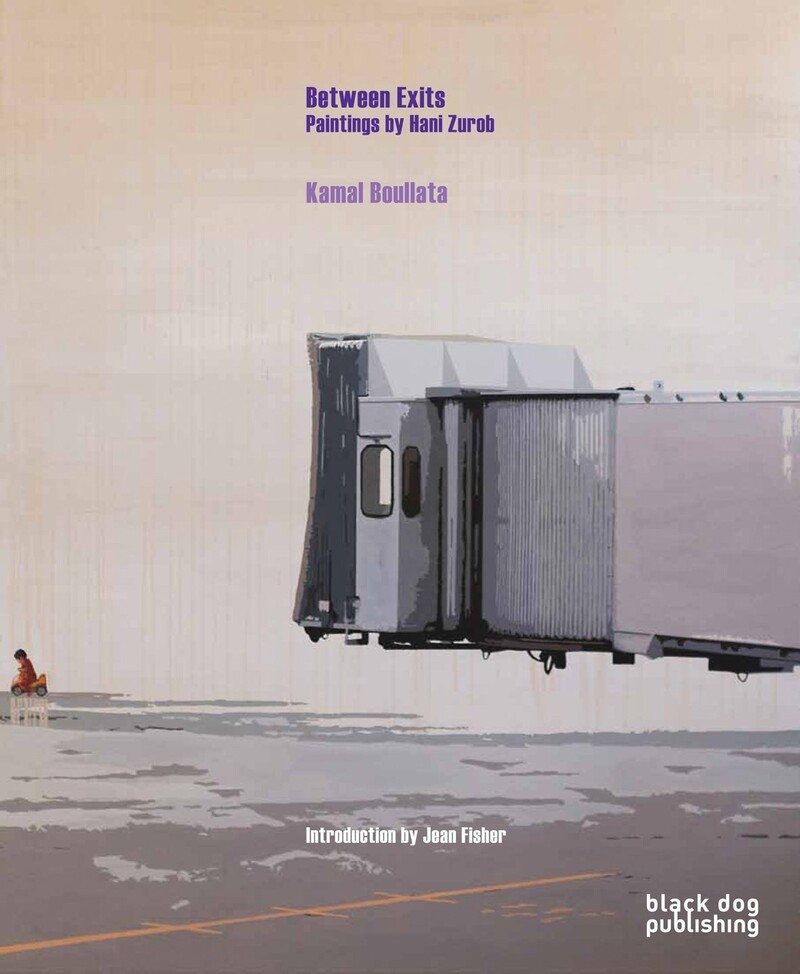The Electronic Intifada 17 June 2013

A Palestinian painter from Gaza, Hani Zurob may have only been practicing as a fine artist since the late 1990s, but he already has an enviable list of solo shows — twelve, spread between Qatar, France, Palestine and Morocco — and joint exhibitions. The latter have included shows in venues as prestigious as L’Institut du Monde Arabe in Paris, the national museums of Bahrain and Syria, and the Henry Moore Institute in the UK. And in January, he was listed as one of The Huffington Post’s “10 international artists to watch in 2013.”
Zurob’s reputation and profile will be further enhanced by the publication of Between Exits, a monograph on his life and work. Despite his comparative youth (he is just 37), this collection of images, alongside a wide-ranging text by Kamal Boullata (probably best known for his monumental book Palestinian Art: From 1850 to the Present), shows just how versatile and energetic an artist Zurob is.
Boullata’s text does not pull any punches in asserting Zurob’s place as an artist whose work deserves attention not because of his national origin or life story, but because of its artistic quality. The preface opens with this challenge: “In a homeland enduring over 40 years of military occupation, where art is saturated with nationalist clichés and tired iconographic images, how does a young and ambitious talent like Hani Zurob break away from the binds of the local mainstream to explore his own originality in painting?”
“No boundaries”
This doesn’t mean that Zurob seeks somehow to place himself “above” his Palestinian origins. On his own website, Zurob states that “I try to place myself as a witness of the situations and the events I experience. That’s why there are no boundaries between political matters and private stories in my work.”
This intertwining of the personal and political is evoked in Boullata’s text, which combines Zurob’s life story with his artistic biography. Both are firmly placed in context, both in terms of the narrative of the Palestinian people and of the development of Palestinian art and its relationship to resistance and national identity. The influences of both Zurob’s experiences of refugee life and the Israeli occupation, and of major Palestinian artists and artistic thinkers such as Ismail Shammout, are a constant refrain.
As Boullata tells it, Hani’s grandfather, Hajj Thabet Zurob, left the family base in Rafah — near Gaza’s border with Egypt — and established himself in Ramleh (in present-day Israel), before being forced back to southern Gaza as a refugee in 1948. Hani was therefore born and raised in the Rafah refugee camp. His first public art consisted of the graffiti and political posters of the first intifada, and despite the initial hopes of the Oslo accords, Israeli restrictions on Palestinian movement meant that he spent the late 1990s studying art at An-Najah University in Nablus as an “illegal,” constantly under threat of being discovered and deported.
Although after his graduation in 1999 Zurob rapidly began to exhibit his work and find commercial success for himself, Boullata locates his growing career in the tricky surroundings of the “Ramallah bubble,” redolent of corruption and detached from most Palestinians’ lives. Eventually, Zurob took the decision to work away from the politics of the Palestinian Authority-influenced West Bank, and left for Paris, where he still lives.
Stifling
Despite the rather technical, workaday training at An-Najah and the drawbacks of Ramallah, Boullata’s narrative also shows how Zurob’s artistic drive led him to seek out knowledge and inspiration, exploring the international art history which hadn’t been a feature of his education. The examples of paintings from his Ramallah period show the influences of painters such as Egon Schiele in their distorted human figures, but also evoke a sense of both the Palestinian political environment and of Zurob’s own stifling personal situation in their cramped, imprisoned bodies.
Boullata’s text acknowledges that it would almost be clichéd to see Zurob’s sudden shift from figurative to abstract paintings as linked to his move to Paris. Despite the apparent abstraction of many of the images, they remain tied to the material world — through the use of strange media such as avocado skins, and of objets trouvés with weighty significance — such as telephone cards used to ring home to Gaza. Similarly, the apparently abstract Barrage and Projections series’ capture in their tones and brush-strokes Zurob’s reaction to attacks on Gaza by the Israeli army, viewed from afar.
Zurob’s exploration of the balance between figurative and abstract art has more recently led him to the paintings which are probably most familiar to Western audiences, having appeared in exhibitions such as Despite in London. In these works, block-color, color-washed or patterned backgrounds contrast with small, highly detailed pictures of Zurob’s young son Qudsi.
Qudsi is shown engaged in the act of travel, or being blocked from movement, a personal instance of the ongoing situation of modern Palestinians. The paintings thus become both intensely intimate, and highly public and political.
Although it traces a comparatively young life, the monograph is a rich blend of biography, artistic criticism and interpretation, and Palestinian political and cultural history.
It is a pity that the lavish production — which includes color reproductions not only of many of Zurob’s paintings, but of contextualizing works by Shammout and by contemporaries of Zurob such as Larissa Sansour and Steve Sabella — wasn’t matched by decent proof-reading, because some of the mistakes are downright distracting. But that’s a small gripe for this important contribution to the documentation of Palestinian culture.
Sarah Irving is a freelance writer. She worked with the International Solidarity Movement in the occupied West Bank in 2001-02 and with Olive Co-op, promoting fair trade Palestinian products and solidarity visits, in 2004-06. She is the author of a biography of Leila Khaled and of the Bradt Guide to Palestine and co-author, with Sharyn Lock, of Gaza: Beneath the Bombs.





